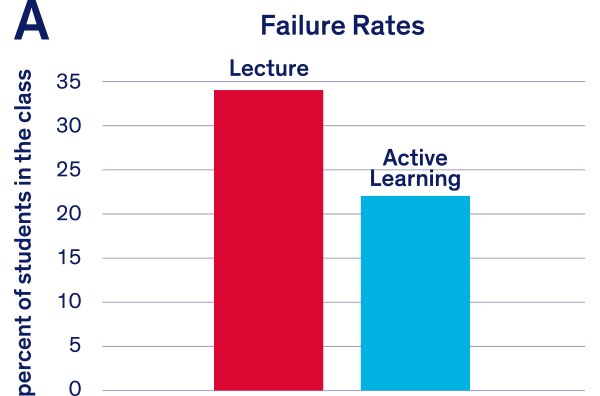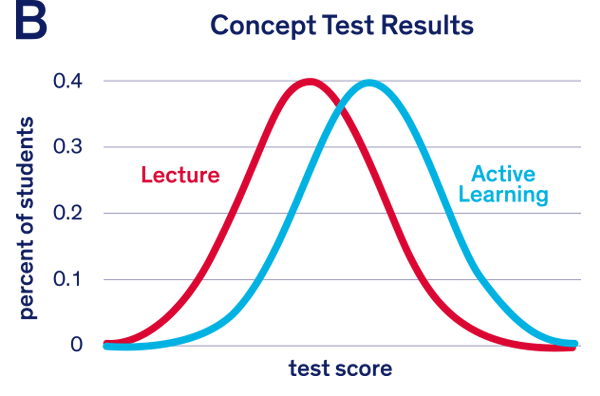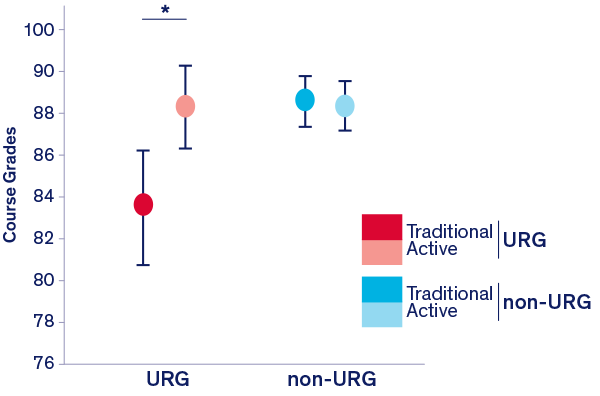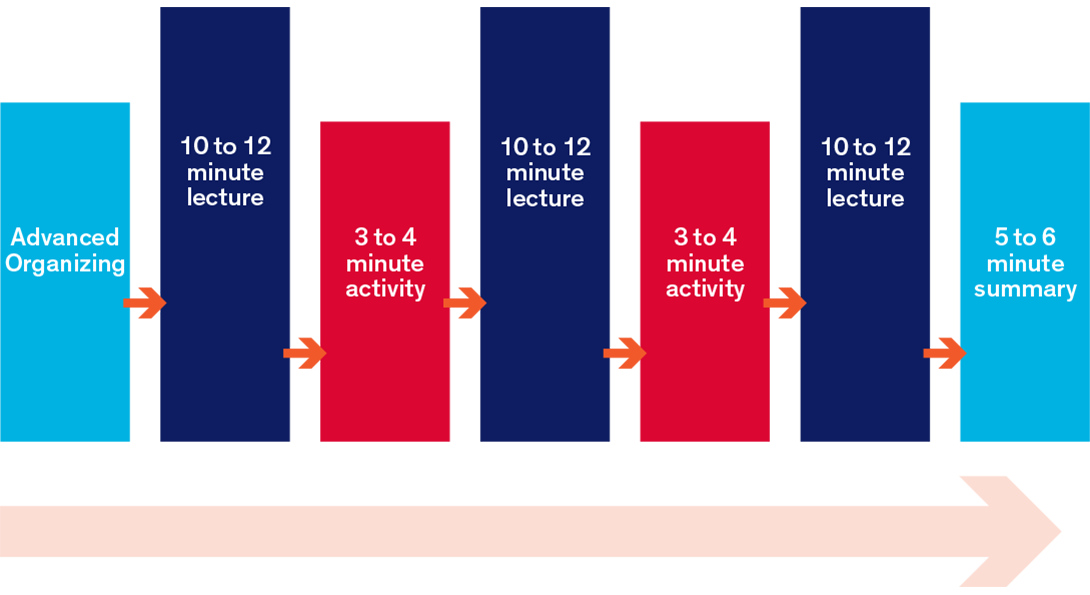Active Learning
Tom Okon, CATE Instructional Designer
March 28, 2022
WHAT Heading link
Active learning is an instructional strategy that can help students take an active role in their learning, by participating in intentionally designed activities during class (Driessen et al. 2020).
1

Active learning.
2
Active Learning encourages students to:
- Self-assess their learning before class
- Tap into their prior knowledge during class
- Reflect on their learning after class.
Active learning is an interactive and engaging process that helps students use cognitive strategies to construct learning by participating in various activities, for example:
- Discussion
- Formative assessment
- Group work
2 Heading link
Active learning stands in contrast to other modes of instruction in which instructors do most of the talking during class and students are primarily passive listeners, as occurs in many lecture-dominated classrooms.
1
Direct instruction in the form of lectures, has been the predominant mode of instruction since universities were founded and is still pervasive in many college classrooms today (Stains et al. 2018) despite evidence showing the benefits of active learning over lecture-dominated formats in both online and in-person learning environments (Freeman et al. 2014, Theobald et al. 2020, Khan et al. 2017).
Learning theories that emphasize the need for students to construct knowledge have long challenged the theoretical underpinnings of the traditional, instructor-focused, “teaching by telling” approach. The 1999 NRC report “How People Learn: Brain, Mind, Experience, and School summarized decades of research in cognitive science and educational psychology supporting instructional practices that encourage students to ask questions and seek answers, as well as challenge students to explore the complexities of relevant, real-world problems.
How People Learn revealed several fundamental aspects of learning, with three points particularly relevant to the use of active learning in our classrooms:
- Individual learners build on prior knowledge
- Learning is promoted by constant feedback
- Active learning is better retained than passive learning
2

These aspects are modeled in an active learning classroom that incorporates activities intentionally designed to engage students, to challenge misconceptions, build on knowledge, and connect new ideas and experiences to existing knowledge to enhance skills and deepen conceptual understanding.
Active learning instruction ensures students receive feedback, have opportunities to self-assess, and monitor progress towards the achievement of the learning objectives. The formative assessment data that is collected during active learning instruction can provide the instructor with information to gauge students’ needs and build scaffolding during the learning process.
WHY Heading link
Active Learning Benefits All Students
1
Hundreds of classroom studies have been undertaken in the past several years to examine the efficacy of active learning in different contexts – varying disciplines, class sizes, institution types, student characteristics, and grade levels, etc. Although active learning is based on learning theories that impact all disciplines, many of the classroom studies have been done in science, technology, engineering, and math (STEM) classes.
This is not because active learning as a teaching practice is something specific to STEM disciplines, it’s just that STEM is where we have observed profound and inequitable student success outcomes attributed to pedagogical practices that include lecture-dominated instruction. As a result, substantial federal funding has been directed for studying the effects of active learning in STEM where lecture-dominated instruction persists (Stains et al. 2018).
2
In 2014, Scott Freeman and colleagues at the University of Washington conducted an extensive quantitative analysis of the research on active learning in college and university STEM courses. Their meta-study of over 200 studies of active learning classrooms showed that average examination scores and performance on concept tests improved in active learning courses compared to lecture-dominated courses and that students in lecture-dominated courses were more likely to fail than were students in classes with active learning (see figure). This meta-study also documented that active learning leads to overall increases in examination performance that would effectively raise average grades by a half a letter grade, and that failure rates in lecture-dominated courses increase by 55% over the rates observed in active learning classrooms. Based on these findings, Freeman and colleagues conclude that it is no longer appropriate to use lecture-dominated instruction as the comparison group, and instead, research studies should compare different active learning methods in different contexts, because there is such overwhelming evidence that the lecture-dominated instruction is substantially less effective than active learning.
2 graphs A n B Heading link
There is such overwhelming evidence that lecture-dominated instruction is substantially less effective than active learning. (Freeman et al.2014)
figure A

Figure A: Students in lecture-dominated courses are 1.5 times more likely to fail than in classes using active learning.
Figure B

Figure B: Performance on identical concept tests increased by 0.88 standard deviations in active learning classroom. Source: Wieman 2014.
3 Heading link
Active Learning Drives Performance Gains for Underserved Students & Promotes Equity in Higher Education
1
Efforts to retain undergraduate students in STEM have shown only limited success in higher education. Specifically, when we examine outcomes such as college grades and graduation rates, we observe a persistent equity gap between students who identify with groups historically underserved and underrepresented in STEM (URG) and their peers (non-URG). Classroom studies have examined the role of active learning in improving college retention rates, looking specifically for its impact on this equity gap. Ballen, Wieman, and colleagues (2017) compared the academic performance outcomes for undergraduate students in lecture-dominated courses with those that integrated active learning. As depicted in the figure, engaging in active learning helped to close the equity gap between URG and non-URG students. In addition to academic outcomes, this same study also examined changes in self-efficacy (a student’s belief in their own ability to achieve the learning objectives and become proficient in a particular subject) and students’ sense of belonging in STEM. The results showed that all students in active learning classrooms experienced an increase in science self-efficacy. Sense of social belonging also increased significantly with active learning, but only for non-URG students. These results add to a growing body of research that supports active learning and inclusive teaching as one pathway to a diversified STEM workforce.
2

Figure C: Comparison of academic performance outcomes (mean semester grades; 95% confidence interval, controlling for incoming academic preparation) among students who identify with groups historically underserved and underrepresented in STEM (URG) and their peers (non-URG) in traditional (lecture-dominated) instruction and courses that integrate active learning. Source: Ballen, Wieman and colleagues (2017).
4 Heading link
Strategies to Encourage Student Participation in Active Learning
1
Despite the evidence supporting the benefits of incorporating active learning into college classes, this teaching strategy has not been widely adopted (Stains et al. 2018). Student resistance is a commonly cited barrier to implementing or sustaining this instructional strategy (Seidel & Tanner 2013; Tharayil et al. 2018). Reactions to any new teaching methods are not uniform across all students in a class, and reactions may even vary over the term, moving, for example, from concerns about grades to the relative contributions of their peers in learning activities.
A study comparing lecture-dominated instruction to classes that integrated active learning found that students who experienced the active learning classroom actually learned more but felt like they learned less and that the instructor was less effective at teaching as compared to a lecture-dominated course (Deslauriers 2019). This study illustrates how students can be “poor judges” of their learning. Strategies that require low cognitive effort — such as passively listening to a lecture — are often perceived by students to be more effective than active learning strategies. Thus, the impetus is on the instructor to address these misconceptions about active learning and mitigate student resistance. Students may not realize that the active learning activities are fostering a productive struggle (Pasquale, 2016) (Kapur & Bielaczyc, 2012) with the challenging aspects of the material. It is helpful if you (and your graduate student TAs in larger courses) are present to create, facilitate, and monitor the process, ensuring students are learning how to struggle positively and productively as engaged and critical thinkers.
2
To help garner buy-in from students, (Ellis, 2015) recommends several strategies that are positively associated with student participation in and feedback about active learning:
- Explain the purpose or value of an activity. If it is an activity that you have implemented in past years, student quotes about key outcomes can be particularly powerful.
- Show data supporting the use of active learning and how it benefits all students in the class.
- Preview what might be challenging in doing a learning activity.
- Clearly describe the process and what students are expected to produce.
- Invite questions from students in the class.
- Walk around the room (or move between breakout rooms on Zoom) during an activity, being mindful to check in with non-participating students by asking questions or checking to see if and how they may be stuck on a particular step or concept.
Sometimes, a few vocal students may give the impression that there is more discontent about a particular teaching practice than there actually is across the entire class, so collecting student feedback (such as using a mid-semester questionnaire) can give a more accurate picture of the range of student experiences.
HOW Heading link
Think of making time for active learning as “chunking the lecture.”
1
When planning how to integrate active learning into your class sessions, you may be concerned that there is not enough time to implement activities, due to the need to cover a specified amount of content. Using techniques like the flipped classroom or “learn before lecture” (LBL) can help overcome this barrier to implementing active learning. Moravec et al. (2017) demonstrated that using LBLs, which shifted the presentation of new material from lecture to pre-class assignments, coupled with related participatory exercises during class, resulted in significant increases in student learning gains in a large introductory biology course.
An additional concern about active learning is the perception that an instructor has to abandon the lecture altogether. This is most definitely not true. Think of making time for active learning as “chunking the lecture.” As depicted in the figure below, this approach entails interleaving shorter lecture segments with a few active learning activities. Notably, a 10-12 min lecture segment better aligns with the attention span of your students, meaning they are more likely to listen and retain the information you’re sharing during this time.
2
To provide an organizational framework of what students will be learning in the class session and to encourage active listening, consider sharing the template for an Advance Organizer before you kick off your lecture segments. Then try wrapping up the class with a summary of what you covered and the insights that were discussed in the activities. You can also use this opportunity to introduce the information and concepts that you will cover in the next class.
By planning out the learning activities in your class sessions, you are adding structure to the lectures and student learning. This structure provides students with an awareness of active listening and active learning opportunities. Structure is a beneficial component for the learning environment as highly structured courses have been found to increase overall performance by all students, compared with a low-structured lecture-intensive course with no required active learning (Haak, 2011).
image Heading link

Figure D: Active Learning entails interweaving lecture segments with active learning activities.
how 2 Heading link
1
Using active learning techniques in your teaching requires only a willingness to try something new in the classroom and plan an activity that furthers your students’ progress towards achieving your learning objectives. With any use of active learning, it is important that the activity be perceived as more than “busy work” or a “break from the lecture.” Rather, the approach should be intentionally selected to allow students to practice applying a key concept or skill coupled to peer and/or instructor feedback (Wiggins et al. 2017).
2
Effective active learning tasks stimulate metacognition, foster discussion, involve peer instruction or group work, integrate feedback facilitating formative assessment, simulate authentic problem-solving using worksheets and games, and engage students in practicing competencies essential to achieving the learning objectives. There are a variety of techniques that can be used in and outside of class to create interactive learning environments for students
Techniques to Introduce Active Learning into your Classroom Heading link
Below is an overview of some techniques you might try in introducing active learning into your course:
-
Guided Notes
1
With Guided Notes, you prepare handouts that provide all students with background information and standard cues with specific spaces to write key facts, concepts, and/or relationships during the lecture. Guided notes require students to actively respond during the lecture, improve the accuracy and efficiency of students’ note-taking, and increase students’ retention of course content. (Konrad et al. 2009)
2
Guided notes can help organize and enhance lecture content in any discipline or subject area. You may develop them for a single lecture, for one or more units within a course, or an entire semester-long course.
-
Polling
1
Use polling to ask students questions about the course material. Polling can provide an opportunity for both you and your students to get feedback on their understanding. It can enhance engagement, provide additional opportunities for formative feedback and reflection, and facilitate peer interaction (Walklet et al., 2016) Classroom polling will allow you to quickly ask a question and instantly receive responses from students during class. Instructors and students can use online/mobile polling with phones, computers, tablets, and iPads.
2
- Pose a multiple-choice question to your students using a polling tool.
- Each student submits an answer to the question using the appropriate response device or app.
- You use the polling software to collect the students’ answers and produce a bar chart showing how many students chose each of the answer choices.
- You can then make “on the fly” instructional choices in response to the bar chart by, for example, leading students in a discussion of the merits of each answer choice or asking students to discuss the question in small groups.
-
Quick Write Activities
1
Use Quick Write activities as a way to activate students’ previous knowledge, enhance their connection of key ideas, or get feedback on their understanding. (Fisher & Frey, 2008). Examples include: Minute paper and Muddiest point (Angelo and Cross, 1993)
Minute Paper
This technique provides a quick and extremely simple way to collect written feedback on student learning. To use the Minute Paper, plan to stop class two or three minutes early and ask students to respond briefly to some variation on the following two questions: “What was the most important thing you learned during this class?” and “What important question remains unanswered?”
Decide first what you want to focus on and, as a consequence, when to administer the Minute Paper. If you want to focus on students’ understanding of a lecture, the last few minutes of class may be the best time. If your focus is on a prior homework assignment, then the first few minutes may be more appropriate.
2
Muddiest Point
A simple technique with a high information return for low effort consists of asking students to give a quick response to one question: “What was the muddiest point in…?” The focus of the Muddiest Point assessment might be a lecture, a discussion, a homework assignment, or a multimedia artifact (Angelo and Cross, 1993).
If you are using the technique in class, reserve a few minutes at the end of the class session. Leave enough time to ask the question, to allow students to respond, and to collect their responses by the usual ending time. Let students know beforehand how much time they will have to respond, and how you will utilize their responses. Respond to the students’ feedback during the next class meeting or as soon as possible afterward.
-
Think-pair-share
1
This activity provides students with adequate time to think in order to increase the quality of their responses and fosters critical thinking skills (Kaddoura, 2013). If you prompt students with a question, they initially try to answer on their own first, then talk to each other and resubmit their answer. Following this process, students are much more likely to get the right answer after talking to a peer and working through the difficulties (Johnson & Johnson, 1999).
2
Think-Pair-Share is a cooperative learning activity that can work in varied size classrooms and in any subject. Instructors pose a question, students first THINK to themselves prior to being instructed to discuss their response with a person sitting near them (PAIR). Finally, the groups SHARE out what they discussed with their partner to the entire class and the discussion continues.
Think-Pair-Share can be a 5-minute activity or something that takes 30 minutes or more. The key to a successful Think-Pair-Share activity is alignment; the question posed must be challenging and align with the instructional goal of the unit/week (Wiggins & McTighe, 1998).
Recommendations for Making Active Learning More Inclusive of Students with Disabilities Heading link
How Can I Make Active Learning Accessible?
1
Active learning significantly changes the usual classroom routines in ways that could create challenges for students with disabilities. A study by Gin et al. (2020) conducted interviews with 37 directors of university Disability Resource Centers (DRCs) across the United States. The study explored their familiarity with active learning, the processes for providing academic accommodations for students with disabilities in active learning courses, and their perceptions of the challenges associated with providing accommodations for students with disabilities in active learning classes.
2
Based on their study and drawing from the literature, they developed recommendations that instructors can use to make active learning more inclusive for students with disabilities and provided examples of active learning accommodations.
There are three general strategies you can take towards making your active learning classroom more accessible to students with disabilities: proactive course design, transparent communication about the course structure, and support for accommodations whenever needed.
Recommendations for making active learning more inclusive of students with disabilities Heading link
-
Design courses using Universal Design for Learning (UDL) principles
1
Incorporate elements of Universal Design for Learning (UDL) into courses to proactively accommodate all learners without specialized adaptation or accommodation. This means ensuring that all videos are closed-captioned, text sources are compatible with screen readers, and additional time is provided for assessments and activities for all students (e.g., giving all students 10 minutes to take a quiz that may only take 5 minutes for most students).
2
Check out this UIC Accessible Teaching and Accommodations quick guide for some specific examples of how to do this.
-
Be transparent about if and how active learning is used in a course
1
To better accommodate students with disabilities in active-learning classrooms, disability resource centers (DRCs) need to know which courses use active learning in general and what teaching practices instructors tend to use specifically so that they can proactively identify solutions for students with disabilities who are enrolled in the courses before students start a class. Many DRC directors also recommend that instructors provide their students the same information they are sharing with the DRC about how their courses will be taught
2
They should disclose that they teach using active learning, and also what instructional practices are used in a course (e.g., small-group work, polling questions using clickers or smartphone apps) in the syllabus, and in course announcements. Being up front about the course elements help DRCs and students proactively work together to identify accommodations in collaboration with the instructor before the class begins.
-
When proactive accommodations are not possible, support students with disabilities as they navigate the retroactive process to seek accommodations
1
Research has shown that individuals with disabilities can experience difficulties with self-advocacy and may specifically struggle with revealing to instructors their need for accommodations Lynch and Gussel, (1996); Brinkerhoff et al.,( 2002); Hong, (2015). For many students, college is the first time that they are solely responsible for advocating for their disability-related needs Eckes and Ochoa, (2005); Ochoa, (2007). Instructors can support students by making an announcement on the first day of class or in their syllabus that invites individuals with disabilities to approach them if they encounter a challenge in their classrooms. Further, instructors can express their willingness to work with students with disabilities to provide appropriate accommodations and can provide students with information about an institution’s disability resource center.
2
Consider including the following statement in your syllabus:
UIC is committed to full inclusion and participation of people with disabilities in all aspects of university life. If you face or anticipate disability-related barriers while at UIC, please connect with the Disability Resource Center (DRC) at drc.uic.edu, via email at drc@uic.edu, or call (312) 413-2183 to create a plan for reasonable accommodations. In order to receive accommodations, you will need to disclose the disability to the DRC, complete an interactive registration process with the DRC, and provide me with a Letter of Accommodation (LOA). Upon receipt of a LOA, I will gladly work with you and the DRC to implement approved accommodations.
Examples of Active Learning Accommodations Heading link
While there is no standardized set of accommodations for active learning, below are several suggestions for some common techniques used in courses across different institutions (Gin et al. 2020).
-
Accommodations for Group Work
1
Directors of disability resource centers (DRCs) most frequently mentioned examples of providing accommodations for small group work. Some of the accommodations involve strategies that instructors could take to ensure constructive group dynamics among students, such as allowing students to choose their groups, instructors predetermining groups for students, and reducing group sizes or allowing students to work in pairs. These accommodations could mean that some students are assigned to the same seats and groups for the entire semester, which allows students to get to know their group members and become comfortable working together.
2
For students who may have a difficult time interacting with group members face-to-face or who may be unable to attend class, directors suggested having students meet with their groups virtually, using an online platform such as Zoom, where students could interact with one another without their video turned on. Notably, it’s important for instructors to weigh and discuss the pros and cons of some of these strategies in consultation with DRC directors and the students themselves to ensure accommodations are in alignment with evidence-based practices (see Group Work Teaching Guide).
-
Accommodations for Polling Questions
1
For students who may need more time to process and answer polling questions typically given during class, instructors can give students access to the questions before class or ask them to complete and submit their responses to the questions after class. Other accommodation approaches include providing students with more time to respond to the question during class either by the instructor reading the question aloud to the entire class before starting the timer (a strategy that is actually helpful to all students, not just those who need extra time) or allowing a student who may need additional time to motion inconspicuously to the instructor after they finished reading the question.
2
Additionally, DRC directors mentioned using classroom aides or volunteers to assist a student (who, for example, may have fine motor disabilities) in physically using the clicker or smartphone app.
-
Accommodations for Random Call
1
Random call (sometimes referred to as cold call) is a strategy used by instructors to more equally engage all students in a whole-class discussion, reducing potential biases in participation (Eddy et al. 2017). When using this technique, it’s important for instructors to expect students to participate while still giving them control over when and how they contribute, regardless of their disability status. Some basic principles to follow when using random call are as follows:
- Prepare a randomized list of student names: Don’t rely on yourself to randomly choose a name.
- Frame it as a safe environment: Make it safe for students to speak up when they are called on.
- Lessen anxiety: Provide an easy option for students to voluntarily remove (and also re-add) themselves to the list.
- Remind students of the benefits: Help students connect the dots about the ways this learning method benefits them such as practicing public speaking and persuasive skills.
- Make it okay to be wrong: “Passing” on a question should always be an option, but instructors who can create a courageous atmosphere find that this happens relatively rarely.
2
Accommodations for random call involve an agreement between the student and instructor about how, if at all, the student wishes to be called on during class. For example, instructors can notify a student before they will be called on, so the student has advanced notice to prepare their response. Alternatively, instructors can lessen anxiety about answering questions by structuring the class so that students discuss with their partners or groups before speaking out in front of the whole class (e.g., implement a think-pair-share activity) to ensure that they have had time to prepare their answers and can speak on behalf of their groups. In other instances, a student might only be called on if their hand is raised or a student may be offered the option to either opt out of answering a question or pass if called on. All of these approaches are excellent suggestions to offer all students as they help to alleviate anxieties around speaking in front of their classmates. As an alternative to speaking in front of the class at all, instructors might instead have students submit their answers through a written form at the end of class.
-
Accommodations for Required Participation
1
In cases where participation is required, instructors need to consider and agree upon a more flexible attendance and participation policy. While missing class is often detrimental in active learning courses, this agreement ensures that there are clear expectations from both the student and instructor regarding participation in terms of the number of classes that can be missed or what constitutes adequate participation in the course.
2
There may be situations in which a student could attend class virtually via Zoom and use polling tools or other educational technology that allows for remote participation in the course.
HOW TO USE/CITE THIS GUIDE Heading link

- This work is licensed under Creative Commons Attribution-NonCommercial 4.0 International.
- This license requires that reusers give credit to the creator. It allows reusers to distribute, remix, adapt, and build upon the material in any medium or format, for noncommercial purposes only.
Please use the following citation to cite this guide:
Okon, Tom (2022). “Active Learning.” Center for the Advancement of Teaching Excellence at the University of Illinois Chicago. Retrieved [today’s date] from https://teaching.uic.edu/resources/teaching-guides/engaged-teaching-strategies/active-learning/
Additional Resources Heading link
-
References
1
Angelo,T.A. & Cross, K.P. (1993) Classroom Assessment Techniques: A Handbook for College Teachers, 2nd Edition ISBN: 978-1-555-42500-5
Arbee Associates: Education Solutions (2013) Classroom: The case for change. Arbeehighereducation.wordpress.com. Retrieved 3/01/2022
Ballen, Wieman et al. (2017) Enhancing Diversity in Undergraduate Science: Self-Efficacy Drives Performance Gains with Active Learning. CBE-Life Sciences Education 16(4): ar56.
Brinkerhoff, L. C., McGuire, J. M., & Shaw, S. F. (2002). Postsecondary education and transition for students with learning disabilities. Austin, TX: Pro-Ed. Retrieved from ERIC (ED463620)
Deslauriers et al (2019) Measuring actual learning versus feeling of learning in response to being actively engaged in the classroom. Proceedings of the National Academy of Sciences Sep 2019, 116 (39) 19251-19257; DOI: 10.1073/pnas.1821936116
Driessen et al. (2020, Demystifying the Meaning of Active Learning in Postsecondary Biology Education | CBE — Life Sciences Education. 359(6383): 1468-7.
Eckes, S. E., & Ochoa, T. A. (2005). Students with disabilities: Transitioning from high school to higher education. American Secondary Education, 33(3), 6–20
Sarah L. Eddy, Sara E. Brownell, and Mary Pat Wenderoth (2017) Gender Gaps in Achievement and Participation in Multiple Introductory Biology Classrooms CBE—Life Sciences Education 13:3, 478-492
Ellis, D.E. (2015). What discourages students from engaging with innovative instructional methods: Creating a barrier framework. Innovative Higher Education, 40: 111-125.
Freeman et al. (2014) Active learning increases student performance in science, engineering, and mathematics. PNAS 111: 8410-15.
Fisher, D., & Frey, N. (2008). Improving adolescent literacy: Content area strategies at work (2nd ed.). Upper Saddle River, NJ: Pearson Prentice Hall.
Gin et al. (2020) Is Active Learning Accessible? Exploring the Process of Providing Accommodations to Students with Disabilities. CBE-Life Sciences Education 19(4): es12. https://www.lifescied.org/doi/10.1187/cbe.20-03-0049
Haak, David & HilleRisLambers, Janneke & Pitre, Emile & Freeman, Scott. (2011). Increased Structure and Active Learning Reduce the Achievement Gap in Introductory Biology. Science (New York, N.Y.). 332. 1213-6. 10.1126/science.1204820.
Hong, B. S. (2015). Qualitative analysis of the barriers college students with disabilities experience in higher education. Journal of College Student Development, 56(3), 209–226.
Khan et al. (2017). Active learning: Engaging students to maximize learning in an online course. Electronic Journal of e-Learning. 15. 107-115.
2
Konrad, M., Joseph, L. M., & Eveleigh, E. (2009). A Meta-Analytic Review of Guided Notes. Education and Treatment of Children, 32(3), 421–444. http://www.jstor.org/stable/42900031
Lynch, R. T., & Gussel, L. (1996). Disclosure and self-advocacy regarding disability-related needs: Strategies to maximize integration in postsecondary education. Journal of Counseling & Development, 74(4), 352–357.
Manu Kapur & Katerine Bielaczyc (2012) Designing for Productive Failure, Journal of the Learning Sciences, 21:1, 45-83, http://dx.doi.org/10.1080/10508406.2011.591717
Messineo, M. (2017). Using the science of learning to improve student learning in sociology classes. Teaching Sociology, 46(1): 1-11.
Moravec M, Williams A, Aguilar-Roca N, O’Dowd DK. Learn before lecture: A strategy that improves learning outcomes in a large introductory biology class. CBE Life Sci Educ. 2010 Winter;9(4):473-81
National Research Council. 1999. How People Learn: Brain, Mind, Experience, and School. Washington, DC: The National Academies Press.https://doi.org/10.17226/6160.
Ochoa, T. A. (2007). Case #16 A special case of diversity: Students with disabilities in higher education. Unleashing Suppressed Voices on College Campuses: Diversity Issues in Higher Education, 19, 193–198
Pasquale, M. ( 2016) Productive Struggle in Mathematics. Interactive STEM Research + Practice Brief. Education Development Center, Inc.
Seidel & Tanner (2013) “What if the students revolt?” – Considering student resistance: origins, options, and opportunities for investigation. CBE-Life Sciences Education 12: 586-595.
Stains et al. (2018) Anatomy of STEM teaching in North American universities. Science, 2018; 359 (6383): 1468 DOI: 10.1126/science.aap8892
Tharayil et al. (2018) Strategies to mitigate student resistance to active learning. International J STEM Education 5: 7 DOI: 10.1186/s40594-018-0102-y
Theobald et al. (2020), Proceedings of the National Academy of Sciences, 117 (12) 6476-6483; DOI: 10.1073/pnas.1916903117
Walklet, Elaine & Davis, Sarah & Farrelly, Daniel & Muse, Kate. (2016). The impact of Student Response Systems on the learning experience of undergraduate psychology students. Psychology Teaching Review. 22. 35-48.
Wieman (2014) Large-scale comparison of science teaching methods sends clear message. PNAS 111(23): 8319-8320.
Wiggins, B.L., Eddy, S.L., Wener-Fligner, L., Freisem, K., Grunspan, D.Z., Theobald, E.J., Timbrook, J., & Crowe, A.J. (2017). ASPECT: A survey to assess student perspective of engagement in an active-learning classroom. CBE Life Sciences Education, 16(2).
Wiggins, G., & McTighe, J. (1998). Understanding by Design. Alexandria, VA: Association for Supervision and Curriculum Development.
Wilson et al. (2018) Group Work
CBE — Life Sciences Education 17:1